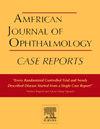黄斑裂孔玻璃体切除术后视网膜前膜的发展
Q3 Medicine
引用次数: 0
摘要
目的报道一例罕见的与颞部半倒置内限制膜(ILM)瓣有关的继发性视网膜前膜(ERM)形成,并探讨其可能的发病机制。一位74岁的妇女因左眼中心视力不正常而来我院就诊。左眼最佳矫正视力(BCVA)为1.0。她被诊断为直径162 μm的3期MH,并采用颞部半倒置ILM瓣技术进行了晶状体切除术。闭合MH,术后1周十进制BCVA仍为1.0。然而,在手术后13个月,变形发生,M-chart评分为0.5°,十进制BCVA降至0.8。光学相干断层扫描显示继发性ERM与强牵引乳头状束(PMB)的视网膜。几天后,随着牵引力的增加,BCVA降至0.6,行第二次玻璃体切除术。再手术后1个月,BCVA改善至0.9,术后6个月,M-chart评分从0.6°改善至0°。结论及重要性颞部半内翻技术有利于改善颞部闭合性,降低医源性PMB损伤的风险。它还能保持黄斑的敏感性。然而,对于较小的MHs,相对较高的自发关闭率以及术后长期形成ERM的潜在风险表明,颞部半内翻ILM瓣技术不应用于此类病例。传统的ILM剥离可能更适合作为小型MHs的主要治疗方法。本文章由计算机程序翻译,如有差异,请以英文原文为准。
Development of secondary epiretinal membrane after vitrectomy with inverted ILM flap technique to treat a macular hole
Purpose
To report a rare case of secondary epiretinal membrane (ERM) formation that appeared to be associated with the temporal hemi-inverted internal limiting membrane (ILM) flap, and to discuss its possible pathogenic mechanism.
Observations
A 74-year-old woman visited our hospital because she was aware that the central vision of her left eye was not normal. Her decimal best-corrected visual acuity (BCVA) in the left eye was 1.0. She was diagnosed with stage 3 MH with a diameter of 162 μm, and she underwent phacovitrectomy using the temporal hemi-inverted ILM flap technique. The MH was closed, and the decimal BCVA was still 1.0 one week post-surgery. However, at 13 months after the surgery, metamorphopsia developed with an M-chart score of 0.5°, and the decimal BCVA was reduced to 0.8. Optical coherence tomography revealed a secondary ERM with strong traction on the papillomacular bundle (PMB) of the retina. Several days later as the traction increased, the BCVA decreased to 0.6, and a second vitrectomy was performed. At one month after the reoperation, the BCVA had improved to 0.9, and at six months post-surgery, the M-chart score improved from 0.6° to 0°.
Conclusions and importance
The temporal hemi-inverted technique is beneficial in improving the closure of MHs, and it reduces the risk of iatrogenic damage of the PMB. It also preserves macular sensitivity. However, for small MHs, the relatively high rate of spontaneous closure combined with the potential risk of postoperative ERM formation in the long term, suggests that the temporal hemi-inverted ILM flap technique should not be used in such cases. Conventional ILM peeling may be more appropriate as a primary treatment for small MHs.
求助全文
通过发布文献求助,成功后即可免费获取论文全文。
去求助
来源期刊

American Journal of Ophthalmology Case Reports
Medicine-Ophthalmology
CiteScore
2.40
自引率
0.00%
发文量
513
审稿时长
16 weeks
期刊介绍:
The American Journal of Ophthalmology Case Reports is a peer-reviewed, scientific publication that welcomes the submission of original, previously unpublished case report manuscripts directed to ophthalmologists and visual science specialists. The cases shall be challenging and stimulating but shall also be presented in an educational format to engage the readers as if they are working alongside with the caring clinician scientists to manage the patients. Submissions shall be clear, concise, and well-documented reports. Brief reports and case series submissions on specific themes are also very welcome.
 求助内容:
求助内容: 应助结果提醒方式:
应助结果提醒方式:


